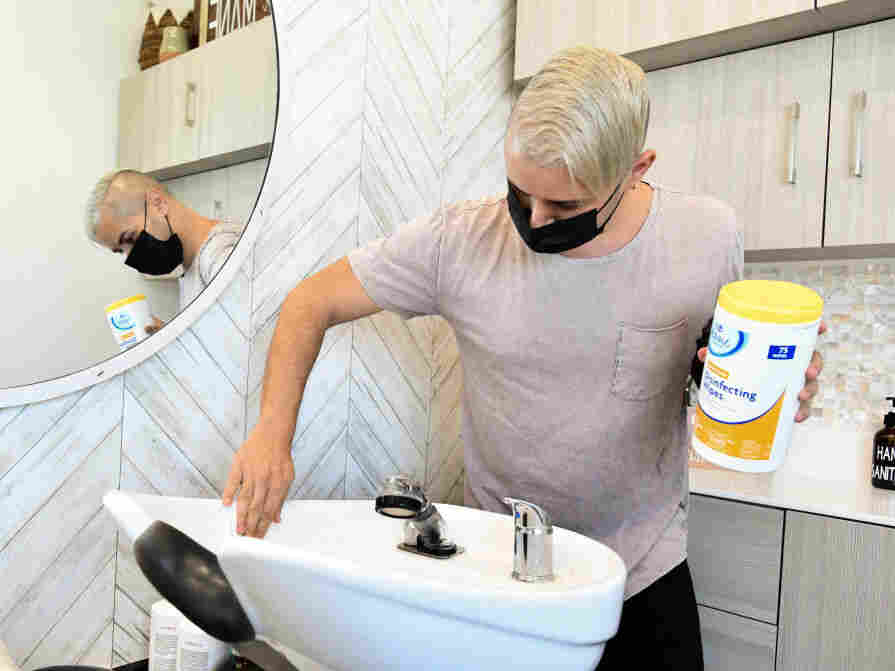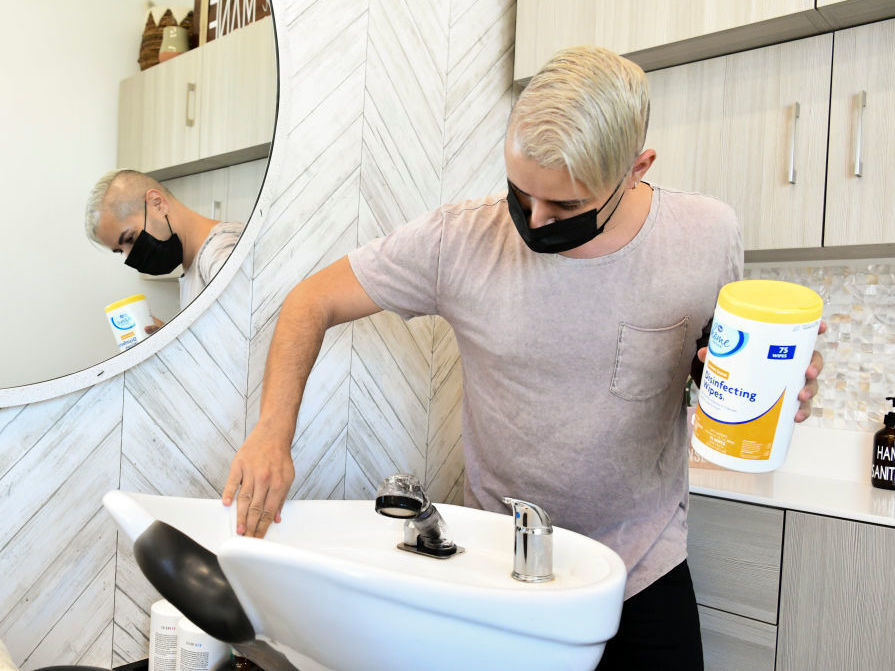
Health researchers say wearing masks and washing your hands often is more important than wiping down surfaces when it comes to protecting yourself from the coronavirus.
Rodin Eckenroth/Getty Images
hide caption
toggle caption
Rodin Eckenroth/Getty Images

Health researchers say wearing masks and washing your hands often is more important than wiping down surfaces when it comes to protecting yourself from the coronavirus.
Rodin Eckenroth/Getty Images
At the start of the pandemic, stores quickly sold out of disinfectant sprays and wipes. People were advised to wipe down their packages and the cans they bought at the grocery store.
But scientists have learned a lot this year about the coronavirus and how it’s transmitted, and it turns out all that scrubbing and disinfecting might not be necessary.
If a person infected with the coronavirus sneezes, coughs or talks loudly, droplets containing particles of the virus can travel through the air and eventually land on nearby surfaces. But the risk of getting infected from touching a surface contaminated by the virus is low, says Emanuel Goldman, a microbiologist at Rutgers University.
“In hospitals, surfaces have been tested near COVID-19 patients, and no infectious virus can be identified,” Goldman says.
What’s found is viral RNA, which is like “the corpse of the virus,” he says. That’s what’s left over after the virus dies.
“They don’t find infectious virus, and that’s because the virus is very fragile in the environment — it decays very quickly,” Goldman says.
Back in January and February, scientists and public health officials thought surface contamination was a problem. In fact, early studies suggested the virus could live on surfaces for days.
It was assumed transmission occurred when an infected person sneezed or coughed on a nearby surface and “you would get the disease by touching those surfaces and then transferring the virus into your eyes, nose or mouth,” says Linsey Marr, an engineering professor at Virginia Tech who studies airborne transmission of infectious disease.
So people were advised to clean common areas with disinfectant, wipe down cans and boxes from the grocery store and even wear gloves.
In retrospect, Marr says that was “overkill.” Today, she says, “all the evidence points toward breathing in the virus from the air as being the most important route of transmission.”
Scientists now know that the early surface studies were done in pristine lab conditions using much larger amounts of virus than would be found in a real-life scenario.
Even so, many of us continue to attack door handles, packages and groceries with disinfectant wipes, and workers across the U.S. spend hours disinfecting surfaces in public areas like airports, buildings and subways.
There’s no scientific data to justify this, says Dr. Kevin Fennelly, a respiratory infection specialist with the National Institutes of Health.
“When you see people doing spray disinfection of streets and sidewalks and walls and subways, I just don’t know of any data that supports the fact that we’re getting infected from viruses that are jumping up from the sidewalk.”
Marr says focusing on cleaning surfaces is not the best way to slow infection.
“Instead of paying so much attention to cleaning surfaces, we might be better off paying attention to cleaning the air, given the finite amount of time and resources,” Marr says.
Fennelly agrees, noting that airborne transmission is more likely in indoor public places like restaurants.
“Why aren’t we doing more to figure out ways to ventilate those areas?” he asks. “It would be better to use ultraviolet germicide and radiation, which we know can kill these viruses in the air.”
Figuring out how to prevent coronavirus transmission in office buildings, schools, bars and restaurants is definitely a challenge, he says, but “we have a lot of really smart engineers and architects and industrial hygienists who know how to handle airborne infection.”
Spraying disinfectant is not only unproductive, but it’s potentially dangerous, according to Delphine Farmer, an atmospheric chemist at Colorado State University.
Heavy use of disinfectants, like bleach and hydrogen peroxide, can “produce toxic molecules that then we breathe,” she warns.
And breathing in toxic particles can affect our health, Farmer says. The molecules can react directly with the cells in lung tissue and cause oxidative stress. And certain molecules are known to be toxic. “It’s like breathing in poison,” she says.
Early on in the pandemic, Farmer says, many people were making cleaning mistakes: “There were a lot of cases of people cleaning their groceries with bleach and vinegar, which is a recipe to create some very nasty chlorine gas, and people were getting quite ill from those side effects.”
Bottom line: Health experts emphasize that the most important way to avoid infection is to stay away from crowds and wear a mask whenever you leave the house. Limit the time you spend in any indoor space with people outside of your own household — and wear a mask when you’re in those spaces.
When you’re out in public, be aware of surfaces you touch, and wash your hands often. It’s much more effective to wash your hands thoroughly than try to clean everything you touch.
And if you do decide to keep wiping down canned goods or packages that arrive at your house, there’s no need for fancy cleaning products; “old-fashioned soap and water” will do just fine, Farmer says.


